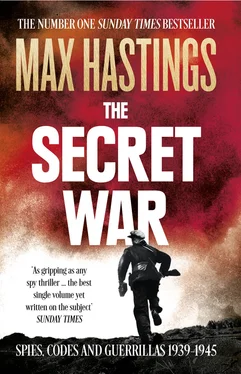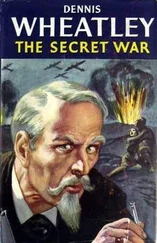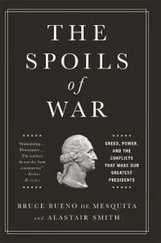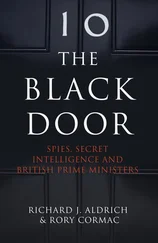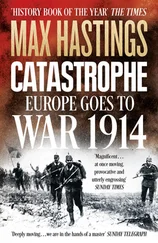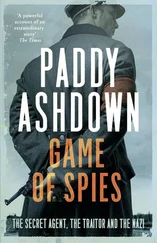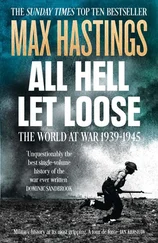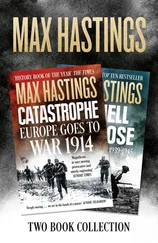Other drafts of young academics followed, variously codebreakers and linguists, together with the first of what became successive waves of young women, who would play a vital role in the operations of ‘BP’. The first two of these were daughters of golfing partners of Denniston, reflecting the importance of personal connections in Bletchley’s recruitment process in the early days, before industrialisation became inescapable. Indeed, the whole wartime intelligence machine emphasised the cosiness of the upper reaches of British life. Oxford University Press was entrusted with responsibility for printing vast quantities of codes, maps and reports, because of its pre-war experience producing examination papers under secure conditions. The Admiralty’s liaison with OUP was handled by Margaret Godfrey, wife of the director of naval intelligence. The Royal Navy’s Topographical Photographic Library was housed in the basement of the nearby Bodleian Library, which eventually dispatched 300,000 images a month to operational areas. The World War I intelligence veteran Admiral Sir William ‘Blinker’ Hall introduced Godfrey, his modern successor, to the City of London banking giants Montagu Norman, Olaf Hambro and the Rothschilds, who helped to identify suitable recruits for the NID.
Candidates being scrutinised for Bletchley were often asked: ‘Do you have religious scruples about reading other people’s correspondence?’ Twenty-year-old Harry Hinsley was interviewed at St John’s College, Cambridge by Alastair Denniston and Col. John Tiltman, the senior codebreaker. They said: ‘You’ve travelled a bit, we understand. You’ve done quite well in your Tripos. What do you think of government service? Would you rather have that than be conscripted?’ Hinsley would indeed, and joined the Naval Section located in Bletchley’s Hut 4. Through the icy winter of 1939–40, such men and women wrestled with Enigma traffic. Working conditions were dismal, with staff muffled in overcoats and mittens. The first break into a Luftwaffe Enigma key – designated ‘Green’ – is thought to have been made on 25 October 1939. In December, by unaided intellectual effort Alan Turing is believed to have broken five days’ worth of old naval messages. By the end of March, the French – or rather, the Poles working at France’s Station Bruno – had broken twenty days’ worth of old signals and BP about thirty, all Luftwaffe traffic.
Turing was much more importantly engaged. He compiled a 150-page treatise on Enigma, studded with schoolboyish blots, deletions and illegibilities. While most codebreakers addressed each other by first names or nicknames, heedless of age and status, almost everyone knew Turing as ‘Prof’ rather than as Alan. When his Enigma study was circulated later in 1940, it became known as ‘the Prof’s book’. He also set about fulfilling his concept for a ‘bombe’, a primitive but revolutionary electro-mechanical device for exploring multiple mathematical combinations. This borrowed its name, though not its design, from the Polish ‘ bomby ’, and would be capable of examining the 17,576 possible wheel deployments for a three-rotor Enigma in about twenty minutes: the order for the first machine was placed in October 1939, and the prototype became operational six months later. Meanwhile, outside in the park, workmen sawed and hammered at an ever-widening array of low wooden buildings which housed the growing staff. Eventually, only administrators worked in the main building, where the telephone switchboard was established in the ballroom. In the huts, signals were shifted from one section to another on a small trolley pushed along a makeshift wooden tunnel.
Hut 8 attacked German naval traffic, which was then passed to Hut 4 for translation and processing. Hut 3 performed the same function for Wehrmacht and Luftwaffe traffic decrypted by Hut 6. The former would eventually play a pivotal role in Allied wartime intelligence, but in its early incarnation it had a staff of just four. Frank Lucas, who was one of them, wrote: ‘On a snowy January morning of 1940, in a small bleak wooden room with nothing but a table and three chairs, the first bundle of Enigma decodes appeared. [We] had no idea what they were about to disclose.’ A few score yards away, Hut 6 run by Gordon Welchman wrestled with army-Luftwaffe ‘Red’ key traffic, which was the first to be broken in bulk.
From the outset, pains were taken to disguise from all but the most senior operational commanders the fact that information was being gained from codebreaking. This gave an unintended boost to the prestige of MI6, and to that of Stewart Menzies in particular. When Reg Jones gave a disguised report based on an Ultra decrypt to the RAF’s director of signals, Air Commodore Nutting, the airman professed astonished admiration for the courage of the presumed spies who had provided the information, saying, ‘By Jove, you’ve got some brave chaps working for you!’ The ever-growing scale of the enemy traffic to be trawled was intimidating. It is a measure of the expansion of communications as a branch of warfare that by August 1943, 305,000 personnel among the Luftwaffe’s total strength of 2.3 million were employed on signals duties – transmitting, receiving or processing – and the same was true on both sides of the war, and of all armed forces.
At GC&CS there were inevitable personality clashes. Gordon Welchman, whose creative contribution became second only to that of Turing, and whose organisational skills were also priceless, found it hard to work with the highly-strung and fractious Dillwyn Knox, a contender for the hotly contested title of Bletchley’s star eccentric. A notoriously awful driver, Knox giggled: ‘It’s amazing how people smile, and apologise to you, when you knock them over.’ He sustained a stream of intemperate complaints and demands to Denniston, his old comrade from Room 40, about staff shortages, working conditions, low pay, together with the intrusion of and excessive authority conceded to non-cryptanalysts: service intelligence officers ‘who maul and conceal our results’. Knox was seriously ill with the cancer that would kill him in February 1943, but meanwhile he and Welchman bickered: the older man accused the younger of exceeding his narrow initial brief, and was also impatient of Turing, writing, ‘He is very difficult to anchor down. He is very clever but quite irresponsible and throws out a mass of suggestions of all degrees of merit. I have just, but only just, enough authority and ability to keep him and his ideas in some sort of order and discipline. But he is very nice about it all.’ Turing prompted mirth by joining Bletchley’s Home Guard because he was seized by an impulse to learn to shoot, then provoked the apoplectic rage of its colonel by absenting himself from parades once he had fulfilled this private purpose. His unworldliness could provoke real exasperation among those under relentless pressure to produce results. A colleague spoke of Turing’s ‘almost total inability to make himself understood’.
There were plenty of minor tantrums lower down the hierarchy, unsurprising when staff were performing stressful tasks through long hours in bleak working conditions. Angus Wilson, the later novelist, once vented such a storm of rage that a colleague said wearily, ‘Do stop it, Angus, otherwise we’ll put you in the lake!’ Wilson retorted defiantly, ‘Don’t worry, I’ll do it myself,’ and duly plunged into the water in front of the house; on another such occasion he hurled a bottle of ink at a Wren. Many wartime codebreakers suffered temporary or permanent physical or mental collapses, brought on by their work: William Friedman, one of America’s pioneer practitioners, underwent a nervous breakdown in January 1941 which incapacitated him for three months. Hugh Trevor-Roper languished for several months at about the same time, and others regularly succumbed.
Читать дальше
